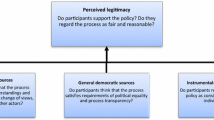Abstract
This paper presents research currently being conducted in Central Queensland, Australia to understand conflicts between coastal zone resource users and the associated sociocultural and political issues surrounding coastal zone management. Conflict occurs between stakeholders in the coastal zone over values, conservation and development trade-offs, access, and resource use rights. Decisions are currently made within a multi-stakeholder framework where there is limited understanding among stakeholders of each groups values and aspirations, and few, mechanisms for negotiation, or to ensure transparency of decisions and feedback on consultation. This paper reports on the contribution of stakeholder analysis and social mapping to conflict management and findings from their application. As it is applied here, stakeholder analysis and social mapping have been successful participatory tools used to document and feed back the values, interests, attitudes and aspirations of stakeholders. Understanding stakeholder conflict is essential in progressing a whole catchment approach to decision-making that secures the cooperation of a diverse range of social groups.
Similar content being viewed by others
Abbreviations
- ICM:
-
Integrated catchment management
References
Bingham, G. 1986.Resolving environmental disputes: a decade of experience. The Conservation Foundation, Washington DC, US.
Cicin-Sain, B. & Knecht, R. W. 1998.Integrated coastal and ocean management: concepts and practices. Island Press, Washington, DC, US.
Dale, A.P. & Lane, M.B. 1994. Strategic perspectives analysis: A procedure for participatory and political social impact assessment.Soc. Nat. Resour. 7: 253–267.
De Lopes, T.T. 2001. Stakeholder management for conservation projects: A case study of Ream National Park, Cambodia.Environ. Manage. 28: 49–60.
Dryzek, J. 1990.Discursive democracy. Cambridge University Press, New York, NY, US.
Elkington, J. 1997.Cannibals with forks: the Triple Bottom Line of 21st century business. Capstone, Oxford, UK.
Heard, C. 2002.The good oil, Insight, 16/05/2002, Available: http://www.sbs.com.au (Accessed 27 May. 2002).
Jennings, S.F. & Lockie, S. 2002.Democratisation and capacity building in coastal zone decision-making in Australia: the application of stakeholder analysis and social mapping. Paper presented at the Coastal Zone Asia Pacific Conference, Bangkok, TH.
Jennings, S.F. & Moore, S.A. 2000. The rhetoric behind regionalization in Australian natural resource management: myth, reality and moving forward.J. Environ. Policy Plann. 2: 177–191.
Lockie, S. 2001. Social Impact Assessment in Review: Setting the Agenda for Impact Assessment in the Twenty-First Century.Impact Assess, Project Appr. 19: 277–287.
Lockie, S. & Jennings, S.F. 2002.Central Queensland healthy waterways survey. Cooperative Research Centre for Coastal Zone, Estuary and Waterway Management, Brisbane.
McCreary, S., Gamman, J., Brooks, B., Whitman, L., Bryson, R., Fuller, B., McInerny, A. & Glaser, R. 2001. Applying a mediated negotiation framework to integrated coastal zone management.Coastal Manage. 29: 183–216.
McGlashan, D.J. & Williams, E. 2003. Stakeholder involvement in coastal decision-making processes.Local Environ. 8: 85–94.
Mitchell, B. & Hollick, M. 1993. Integrated catchment management in Western Australia: The transition from concept to implementation.Environ. Manage. 17: 735–743.
Ramanathan, R. 2001. A note on the use of the analytic hierarchy process for environmental impact assessment.J. Environ. Manage. 63: 27–35.
Reeve, I. 2001. Property rights and natural resource management: tiptoeing round the slumbering dragon. In: Lockie, S. & Bourke, L. (eds.)Rurality bites: the social and environmental transformation of rural Australia, pp. 257–269. Pluto Press, Sydney, AU.
Stolp, A. 1999.Citizen values profiling: an impact assessment tool to investigate citizens' judgements Paper presented at the 19th Annual Meeting of International Association for Impact Assessment, 15–19 June 1999, Glasgow, UK.
Wescott, G. 2002. Integrated natural resource management in Australia: the opportunity offered by a national Coastal Policy.Aust. J. Environ. Manage. 9: 138–140.
Westmacott, G. 1998. Reforming coastal management to improve community participation and integration in Victoria, Australia.Coastal Manage. 26: 3–15.
Author information
Authors and Affiliations
Corresponding author
Rights and permissions
About this article
Cite this article
Rockloff, S.F., Lockie, S. Participatory tools for coastal zone management: Use of stakeholder analysis and social mapping in Australia. J Coast Conserv 10, 81–92 (2004). https://doi.org/10.1652/1400-0350(2004)010[0081:PTFCZM]2.0.CO;2
Received:
Revised:
Accepted:
Issue Date:
DOI: https://doi.org/10.1652/1400-0350(2004)010[0081:PTFCZM]2.0.CO;2




